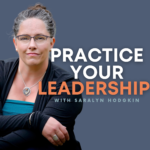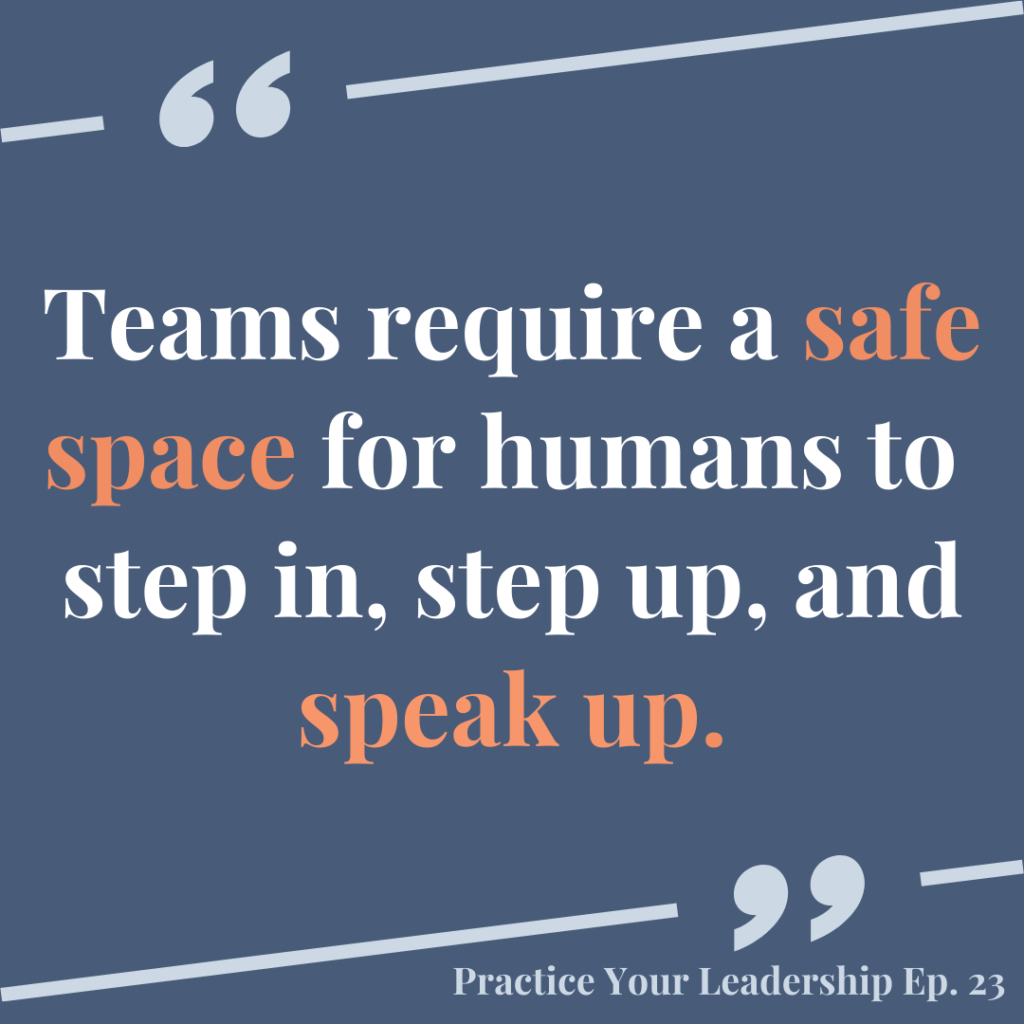Hi, everyone. I’m Saralyn Hodgkin. And this is the podcast to practice your leadership.
Teams learning out loud, man does that ever need some bravery? It requires us as individuals on a team to step up, step in, speak up. It means to think with our head, our hearts, and our guts. And to express that, it means to be able to ask questions without having the answers, and to ask those questions when they’re untimely, when they may not be popular questions. Who the hell is going to jump into that brave space?
That sounds hard, and it is hard. And unfortunately, it is required in order for teams to be able to do the work that they are formed for. Those teams require a brave space for humans to step in, step up, and speak up.
Man, cultivating those brave spaces, takes effort, intention, resources, it requires us to tap in, from a self leadership perspective, tap into our own work of surfacing what is uncomfortable in us, in the effects we have on others, and the unconscious biases that we are trying to surface that we need to see, sometimes conscious biases. And it means that we have to do our own self work. So that we can contribute to cultivating these brave spaces.
How we work together quickly turns to a conversation on what psychological safety and bravery looks like on our team. And that can be a really uncomfortable conversation. And it can be really difficult. A difficult one to have if you’re trying to cultivate brave space, because it means shining a light on our team about what’s supporting us all to show up in front of one or the other. And what’s eroding some of that social capital, some of that bravery, some of that attempt, some of that time, some of that emotional labour, to show up in bravery and psychological safety on this team.
What are the behaviors, the norms, the patterns, the blind spots, that are eroding the efforts to cultivate this brave space? To cultivate the conditions of psychological safety on this team so that we can work together, so that we can be in relationship together, so that we be intentional on our behaviors. Also, that we can align ourselves, our hearts, our minds, our efforts, our heads, our hands, so we can align ourselves towards the impact that we were formed for, that we came together for?
How do we dip our toe in the water on just creating the space, the intention and attention to working on psychological safety for our team? Well, first thing you got to do is define it. Very first thing, Amy Edmondson, of course, is a key thought leader in this arena. And she defined psychological safety as a belief that no one will be punished or humiliated for speaking up with ideas, with questions, with concerns or mistakes.
And so if that’s the definition, and if our team is trying to work towards psychological safety, then when we look at this definition, where are our gaps to working towards people not feeling like they’ll be punished or humiliated for stepping up? What are the insights when we read that definition? What are our team’s insights about how we align or don’t align with that definition? About what the realities are?
In the effects of our team dynamics, what are the reality of those effects on individuals? On individuals feeling like they will commit to the emotional labour to step in and step up? What are our team’s initial, just, curiosities about what psychological safety, from its definition, looks like for us?
Amy Edmondson, she has this assessment or quiz, test, whatever it is, it’s seven short questions that individuals on the team can do and it talks about you know, if you make a mistake on the team, is it held against you know, agree, strongly disagree, that kind of rating. Do members feel like they can bring problems up, tough issues up? Do people feel rejected for being different or having different thoughts? Is it difficult to ask for help on the team like these questions?
On the test that she provides, can help the team together, explore the lived experience of what psychological safety looks like on this team.
So define it. Number two, of course, I’m alluding to talk about it. My gosh, the inner work of teams requires using the oldest technology in the world, it’s called talking.
So if we’re, if we’re defining it, and we’re trying to, to reveal and surface what psychological safety and bravery means on our team, then we’ve got to talk about it. So how do you do that?
Can you invite the team into a brave space to have some conversation, actually brave space, an invitation into brave space, we’ll, we’ll put this as a resource. But it starts, it’s a beautiful poem that starts with together we will create a brave space because there’s no such thing as a safe space. We exist in the real world, we all carry scars, and we have all caused wounds. In this space, we seek to turn down the volume of the outside world, we amplify voices that fight to be heard elsewhere. We call each other to more truth and love, we have the right to start somewhere and continue to grow, we have the responsibility to examine what we think we know. We will not be perfect, this space will not be perfect. It will not always be what we wish it to be. But it will be our brave space together and we will work on it side by side.
Brave space all, cultivating that brave space. You can use prompts like what are we afraid of? Where does fear live amongst us? What does burnout look like? What does imposter syndrome look like in ourselves and in our team, you can have some of these deep conversations and then, you know, number three is you just, you take all this, you start doing something different, like brave space talks about you know, this space will not be perfect. And we will start where we are and and journey from there. And so what are the resources and attention that we can put in place to start experimenting together? What shifts can happen, what levers we can pull, for change in our team to move us towards greater psychological safety and towards bravery? What rhythms and processes can we put together to do this?
This inner work of teams all, of creating these brave spaces for ourselves resonate out into the world in individuals, and our teams, and our organizations to hold brave space for others and to show up bravely, consciously and intentionally bravely, in those spaces that we just show up in.
Do your own work teams. Cultivate that brave space.
Thanks all, I’m Saralyn. You can find me at holonleadership.org. I walk alongside you as you practice your leadership.



 Apple Podcasts
Apple Podcasts Spotify
Spotify Google Podcasts
Google Podcasts